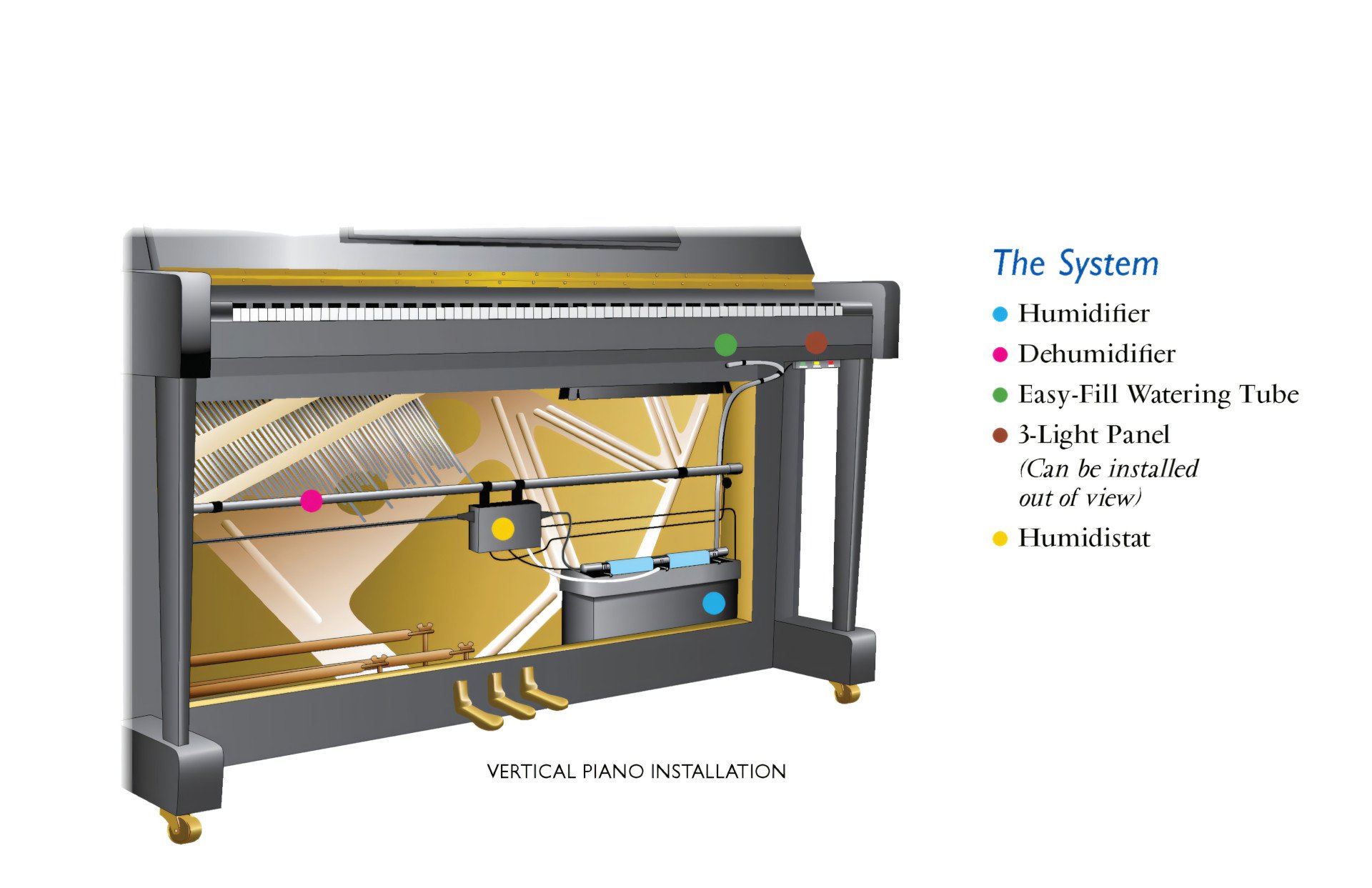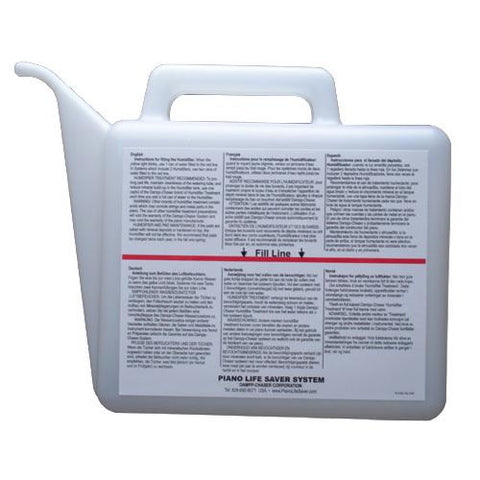A Dampp-Chaser Piano Life Saver System is one of the best investments a piano owner can make—but it’s also one of the easiest systems to forget about. When neglected or misunderstood, it can actually do more harm than good. I’ve received many panicked calls over the years! Here are the top five mistakes I see as a technician, and how you can avoid them to protect your piano.
1. Not Raising the Fill Container High Enough
I once had a customer complain to me that it took her over thirty minutes to fill her Dampp-Chaser. I was baffled. She demonstrated her technique, and sure enough, the water slowly dribbled. She’d actually bring over a stool, prop up the container, and read a book while it filled. Apparently she’d been doing this for years!
Many people don’t realize the Dampp-Chaser humidifier tank is gravity-fed. If you’re filling the Dampp-Chaser in your grand piano, make sure to raise the fill container up high. With the fill container inserted in the hose, you can safely turn it all the way sideways! It should fill up in about thirty seconds.
When filling the humidifier, lift the fill container at or above the top of your grand piano so that gravity lets it flow into the Dampp-Chaser.
2. Skipping the Pad Treatment or Using Alternative Treatment
The Dampp-Chaser pad treatment is essential to prevent mold, scale buildup, and bacterial growth in the water tank and pads. If you don’t use it, your technician will be able to tell when he or she replaces them, because they’ll be covered in slime or mold.
You also should restrict yourself to using Dampp-Chaser’s pad treatment. I understand there are cheaper humidifier treatments out there; however, Dampp-Chaser specifically formulates theirs without harmful or corrosive chemicals such as chlorine. Because the humidifier uses heat to evaporate the water, chemical reactions can happen at an accelerated rate. Don’t accidentally start a chemistry experiment under your piano! Plus, a 16oz bottle will last most people well over a year.
A customer of mine was once told by her technician that she only needed to use half a capful. I learned of this because, every time I replaced her wicks, they were covered in mold. I’d ask her if she was using the pad treatment, and she’d insist she was. Only after nearly two years—and my considerable confusion—did she finally admit she wasn’t using the full dose!
Always use one capful of pad treatment per fill. Never substitute vinegar, alternative brands of treatment, or other home remedies—they can damage the system or create unwanted chemical reactions.

3. Using Tap Water Instead of Distilled Water
Tap water contains minerals that build up inside the Dampp-Chaser’s humidifier. Over time, this causes the system to work less efficiently or stop working entirely. Worse, some elements in tap water can be corrosive, and so can damage the humidifier element and the surrounding hardware.
Always use distilled water when filling your Dampp-Chaser. The only exception is when you have no distilled water on hand, and the system might run out, as described below.
4. Letting It Run Out of Water
Don’t do it! Pianos are creatures of humidity, and the Dampp-Chaser keeps the humidity optimal. If you let the humidifier run out, then over the course of the next few days, the piano’s tuning can noticeably change. The effect is so dramatic that I evaluate it as equivalent to moving the piano.
I typically don’t tune a piano that’s run dry. I’ll fill the Dampp-Chaser, and then return in two weeks to tune it. Yes, it’s just that important!
Check the indicator light regularly, especially in the winter. And yes, despite what I just said above, if you’re out of distilled water, it’s better to use tap water than nothing at all. Drying out completely is the worst-case scenario. Just be sure to switch back as soon as you can.
5. Not Telling Your Technician You Have a System Installed
The Dampp-Chaser system needs to be active for at least two weeks before a scheduled tuning. Otherwise, your piano may still be adjusting to recent humidity changes and the tuning won’t hold well. Technicians also often carry pad treatment and pads at a discounted rate, and will typically add time to check your system during a tuning. This is essential because having multiple technicians inspect your system increases the chances of catching installation errors or components that have shifted out of place.
Let your technician know when booking the appointment. If the system has been off or neglected, they’ll recommend a delay so that your piano can stabilize first.
Bonus: “Rotating” your Dampp-Chaser Pads does absolutely nothing
I heard from one customer that her piano technician had, rather than replace her pads, simply “rotated” them. This evidently meant he flipped them over, rather than replacing them. This is a 10/10 on the bogus scale.
It sounds almost plausible because the tops of the pads are covered in sediment and discoloration, so when you flip them over, they look new. But they aren’t. They still wick like older, used pads that need to be replaced. And worse, you’ve now put all of that sediment (much of which can be corrosive) in direct contact with your humidifier rod.
Just replace the Dampp-Chaser pads. If your technician doesn’t stock them, buy them yourself. Don’t ever let your technician rotate or flip them.
Another Bonus: If the Red Light is blinking and the Yellow isn’t, call your tech!
If the yellow light isn’t blinking, do not fill your Dampp-Chaser. You should only fill the Dampp-Chaser when the yellow light is blinking. I once had a customer flood her upright piano because the red pads light was blinking. This light indicates the system needs service, not that you should fill it!
Final Tip
If you’re not sure your system is working properly, or if you inherited a piano with a Dampp-Chaser already installed, schedule a quick check-up. A five-minute inspection could prevent a costly repair down the road.
Taking care of your Dampp-Chaser means it can take care of your piano—quietly, in the background, year after year. See my Dampp-Chaser Piano Life Saver System: Complete Guide & FAQ for more! And see the official Dampp-Chaser Piano Life Saver System for more information.

